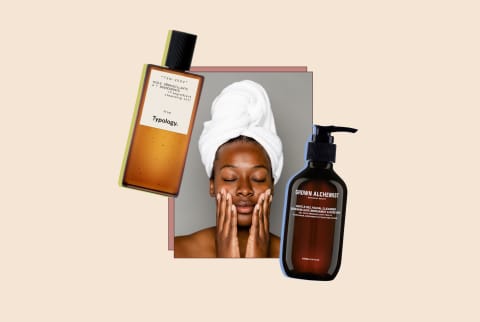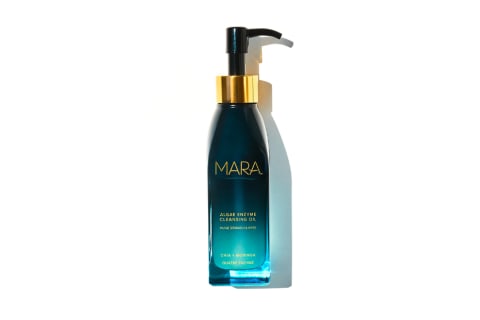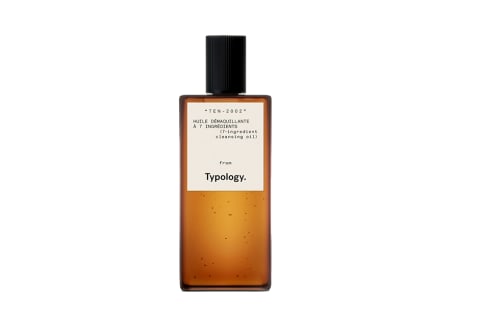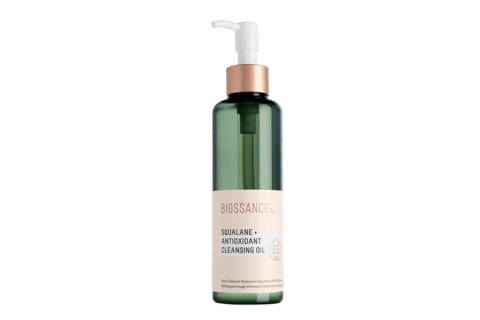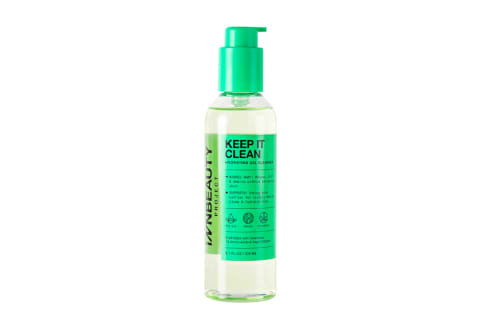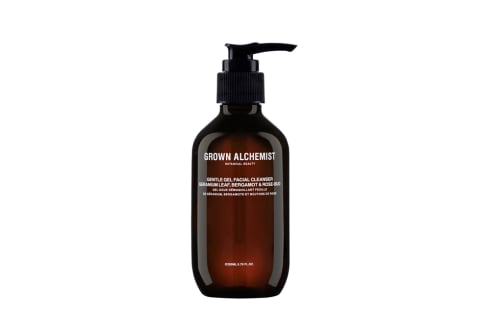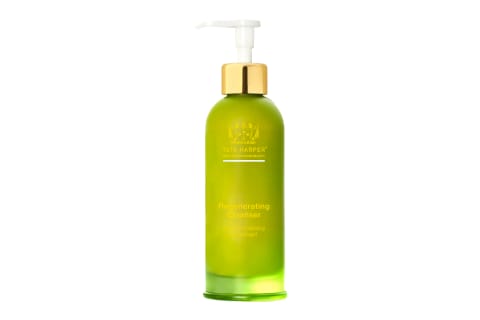If you’re ready to make your routine less wasteful and nourish your skin, this practice is for you. Here’s the 101 on benefits and how to optimize the first cleanse for each skin type, all from experts. Thanks to the popular K-Beauty (short for Korean beauty) 10-step skin-care regimen (double-cleansing makes up the first two steps), the trend continues to rise in popularity and has caught on worldwide. Korean beauty products tend to prioritize the skin barrier and hydration first and foremost, so an oil-based cleanser naturally fits into this philosophy. “Using an oil-based cleanser helps to balance oil within the skin by replacing sebum in clogged, dirty pores with beneficial oils that help to hydrate and maintain skin’s barrier,” board-certified dermatologist Kim Nichols M.D., FAAD, of NicholsMD, tells mbg. As you may already know, a happy skin barrier is essential to maintaining healthy skin overall. This step is generally reserved for night cleansing only, as there’s less to wash off upon waking. However, some skin types may prefer to use just an oil cleanser in the morning, so keep that in mind as one option. After you wash off the oil cleanser, your second cleanse (more on this next) will be able to deeply clean the skin without having to break through makeup, dirt, bacteria, and the like. Plus, the rest of your routine will be even more effective. “By properly eliminating buildup, makeup, and sunscreen, it ensures that the rest of the skin care routine can properly penetrate,” board-certified dermatologist Marisa Garshick, M.D., FAAD, tells mbg. These oil-based cleansers come in many different forms from balms to micellar cleansers (which have oil micelles in them) and simple oil washes. The important thing in choosing a product is to keep your skin type in mind, which will help guide your oil selection (more on that later). “The second, water-based cleanser should target each individual’s skin care concerns to either exfoliate, smooth, brighten, or hydrate the skin,” Nichols notes. We’ll dive deeper into which second cleansers are best for each skin type, but just know that customizing this step is just as important as your oil cleanser selection. Once you’ve tried this step, you’ll understand the hype—oil removes makeup even more easily than popular alternatives. “Makeup and SPF are usually heavy oil-based products, so it’s easy for oil-based cleansers to break that down since the molecular structure is similar,” esthetician and skin care educator at Heyday Skincare Glenise Gomez tells mbg. “A great example is using oils to remove waterproof makeup like mascara,” she continues. Even the most stubborn makeup out there will easily melt away with an oil cleanser—something you can’t say about every makeup remover. “Oil cleansing can help to balance oil within the skin, as it helps to remove oil without stripping the skin of its natural oils or leading to dryness,” Garshick explains. “Excessive dryness of the skin can actually cause the skin to produce more oil,” she continues. So, by feeding your skin with nourishing, noncomedogenic oil during your cleanse, your skin won’t feel the need to overproduce sebum to hydrate your skin. Not to mention, those prone to breakouts should be putting an emphasis on getting a deep cleanse every night, and oil cleansers are the perfect tool. “Oil-based cleansers effectively cleanse the skin of dirt and bacteria without dehydrating skin; in fact, they often help to replenish hydration levels within the skin and aid in restoring skin’s barrier,” she continues. “Oils also have the capacity to lock in moisture, thus omitting damage to the skin’s barrier and minimizing inflammation,” Gomez explains. “Oil cleanser is best used on dry skin because oil and water do not mix well,” Garshick says. “Oil is attracted to oil, so when applied to dry skin, it works to eliminate excess oil and can help to gently but effectively remove makeup and buildup,” she adds. Use a little over a quarter size of oil cleanser or balm. If you have a balm-like product, you may want to massage it in between your hands before applying it to the skin to ensure the oil is in liquid form, making it easier to spread. Rub the cleanser onto your skin in circular motions, and be sure to lightly massage oil on the eyelids and lashes (with eyes closed, of course). If you wear makeup and sunscreen on your neck, be sure to get that area covered as well. In general, you’ll want to do this for about 15 to 20 seconds. Each product is different, so be sure to check the label on your cleanser to double-check. Rub the cleanser between your fingers and then apply it to the skin. Just like with your oil cleanser, you should rub the water-based wash on your skin in circular motions. Be sure to get into the neck and hairline, too. For anyone using an exfoliating cleanser with chemical exfoliants (like salicylic acid), benzoyl peroxide, or small oil beads, keep the cleanser away from your eye area. If you already went in with a dry oil cleanse, then your mascara, shadow, and liner should come off without the extra cleanse. If not, go in with micellar water afterward. If you’ve rinsed your skin for about 15 seconds, your product is likely gone. If you over-rinse, you run the risk of drying out your skin. After that, your skin will start to absorb the water left on your face, which will assist in maintaining moisture balance. However, if you’re using any form of retinol or chemical exfoliant serums (AHAs, BHAs, etc.), then it’s best to apply them to dry skin. When you apply a product to damp skin, it will absorb more of the product, and it will penetrate deeper into the skin. This is great for hydrating ingredients but not the best for actives like retinol. If you do apply retinol to damp skin, you’ll run the risk of irritation, redness, and the like. Some products, like prescription-grade retinoids, call for a 30-minute wait time between cleansing and application, so check the label on your product or ask your dermatologist for the best application protocol. One particularly beneficial oil for acne-prone skin is rosehip seed, as it’s rich in vitamin A—the same ingredient that makes retinol. The Pai Light Work Rosehip Cleansing Oil is one A+ pick—especially for those with sensitive and acne-prone skin. You may also consider a water-based cleanser with ingredients like salicylic acid, mandelic acid, gentle physical exfoliants (like oil-based beads), or astringents like tea tree oil. The Biba Los Angeles Mandelic Cleansing Gel is ideal for those with breakouts who want a gentle (yet effective) second cleanse. As for the water-based cleanser, look for something gentle and hydrating. Dry skin types may prefer a creamy cleanser as opposed to a gel cleanser, like the Alpyn Beauty Juneberry & Collagen Hydrating Cold Cream Cleanser. Be sure not to cleanse the skin for too long (no longer than a minute), as you’ll run the risk of stripping the skin. Simple formulas will be your best friend. The Typology 7-Ingredient Cleansing Oil is a perfect fit—it’s packed with nutrient-dense oils like sunflower seed and sweet almond oil and derivatives of coconut. Sensitive skin types can be oily or dry, so consider any fragrance-free water-based cleanser in each category depending on how your skin feels. For both oily and dry skin types with sensitivity, the First Aid Beauty Face Cleanser is an ideal option for your second cleanse. As for your water-based cleanser, look for a hydrating gel formula like the Inn Beauty Keep It Clean gel cleanser. This way your skin will be deeply cleansed without stripping too much moisture. Plus, this one is a great year-round staple that will meet your skin where it’s at, whether it be on the drier or oilier side.


